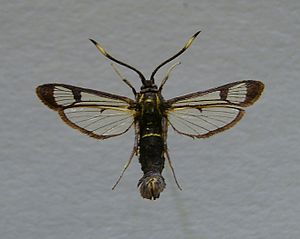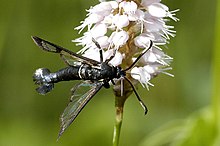Alder-winged winged alder
| Alder-winged winged alder | ||||||||||||
|---|---|---|---|---|---|---|---|---|---|---|---|---|

Alder glass-winged ( Synanthedon spheciformis ) |
||||||||||||
| Systematics | ||||||||||||
|
||||||||||||
| Scientific name | ||||||||||||
| Synanthedon spheciformis | ||||||||||||
| ( Denis & Schiffermüller , 1775) |

The alder glass-winged butterfly ( Synanthedon spheciformis ) is a butterfly from the glass-winged family (Sesiidae).
features
The moths reach a wingspan of 22 to 30 millimeters. The yellow and white probe tips are particularly striking. The wings are transparent, their wing veins , the center point and the edges are black. The abdomen is darkly scaled with a yellow ring on the second segment. The anal tuft is black-blue in color. The eggs are flat, oval and dark brown. The caterpillars are walnut, flattened on both sides, yellow-white with a brown-red head. The doll is light yellow.
Similar species
The most noticeable distinguishing feature from the very similar Great Birch Glass-winged Wing ( Synanthedon scoliaeformis ) is a black-blue anus tuft, which is orange-yellow in scoliaeformis .
Occurrence
The species is widespread almost everywhere in Europe, including Germany. In the mountains it can be found up to an altitude of 1500 meters. The distribution also extends to the following countries and regions: in the north of Scotland to the north of the Arctic Circle , in the east to Siberia , in the south of northern Portugal , Spain and northern Italy to parts of the Balkans and in the west to southern France . The animals are preferably in marshes , meandering streams before and alder groves rich in humid areas.
Way of life
The species needs young growth of black alder or silver birch and colonizes new stocks quickly. When the trees get too old, the species disappears again. The diurnal moths are inconspicuous and like to suckle on different flowers. After hatching from the egg, the caterpillars first dig into the root rashes of young trees, live in the sapwood under the tree bark throughout the summer and dig deeper into the rootstock in autumn to overwinter there for the first time. In the following spring they penetrate deeper into the wood via a feeding tunnel. The adult caterpillar creates a passage with the future loophole before the second wintering. There it pupates without a cocoon. After hatching, the males immediately look for the females that are sending out pheromones . The male moths also like to fly to pheromone preparations . At times hundreds, even thousands, will be attracted by such bait . With such mass occurrences, the species can also be harmful in alder or birch stands.
Flight and caterpillar times
The moths fly from late May to late June, the caterpillars are found from July to May of the year after next. d. i.e., they hibernate twice.
Food of the caterpillars
The caterpillars feed on the roots, bark and wood of the following trees:
- Black Alder ( Alnus glutinosa )
- Silver birch ( Betula pendula )
- Downy birch ( Betula pubescens )
- Green Alder ( Alnus viridis )
- Gray alder ( Alnus incana )
Synonyms
- Sesia spheciformis
- Sesia sphegiformis
- Trochilium spheciformis
- Conopia spheciformis
swell
Individual evidence
- ^ A b Walter Forster , Theodor A. Wohlfahrt : The butterflies of Central Europe. Volume 3: Weirdos and Swarmers. (Bombyces and Sphinges). Franckh'sche Verlagshandlung, Stuttgart 1960, DNB 456642196 .
- ↑ a b Manfred Koch , Wolfgang Heinicke: We determine butterflies. 3. Edition. Neumann, Radebeul 1991, ISBN 3-7402-0092-8 .
- ↑ a b c d e Günter Ebert (Ed.): The Butterflies of Baden-Württemberg Volume 5, Moths III (Sesiidae, Arctiidae, Noctuidae). Ulmer Verlag, Stuttgart 1997, ISBN 3-8001-3481-0
literature
- Günter Ebert (Ed.): The Butterflies of Baden-Württemberg Volume 5, Moths III (Sesiidae, Arctiidae, Noctuidae). Ulmer Verlag, Stuttgart 1997, ISBN 3-8001-3481-0
Web links
- Synanthedon spheciformis in Fauna Europaea. Retrieved May 2, 2011